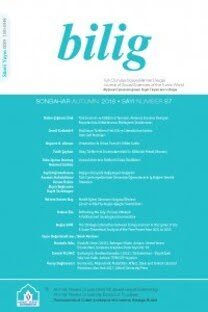Ücretin İşyerindeki Yıldırma Olgusu Üzerindeki Etkisi
The Effect of Wage on Mobbing at Work
___
Adams, Andrea (1992). "Holding out Against Workplace Harrassment and Bullying". Personel Management 24: 38-50.Ashforth, Blake (1994). "Petty tyranny in organizations". Human Relation 47: 151-171.
Asun, Akutlu Tuncer ve Safran Barış (2006). "Örgütlerde Yıldırma Uygulamaları (MOBBING) ve Çatışma Arasındaki İlişki". Selçuk Üniversitesi İktisadi ve İdari Bilimler Fakültesi Sosyal ve Ekonomik Araştırmalar Dergisi 6(11): 111-129.
Bjorkqvis,t Kaj, Karin Osterman and Monika Hjelt-Back (1994). "Aggression among university employees". Aggressive Behaviour 20: 173-184
-Karin Osterman and Kirsti M.J.Lagerspetz (1994). "Sex Differences in Covert Aggression Among Adults", Aggressive Behaviour 20: 27-33.
Bassman, Emily S. (1992). Abuse in the Workplace: Management remedies and bottom line impact. Westerpotr C.T. Quorum Books
Coyne, Iain, Elizabeth Seigne and Peter Randall (2000). "Personality Traits as Predictors of Workplace Bully-Victim Status". Proceedings of the British Psychological Society Division of Occupational Psychology Annual Conference. Brighton. 193-198. Society Occupational Psychology Conference
Davenport, Nicholas, Rochelle D. Schwartz and Graeme P. Eliot (2003). Mobbing: İşyerinde Duygusal Taciz. Çev. Olcay. C. Önertoy. İstanbul: Sistem Yay.
Earnshow, Jill and Cary L Cooper (1996). Stress and Employer Liability. London
Einersen, Stale, Bjorn I Raknes, Stig. B. Matthiesen and O.H. Hellesoy (1996). "Bullying at Work and its Relationships with Health Complaints: Moderating effects of social support and personality". Nordisk Psykologi 48: 116-137.
Einersen, Stale and Anders Skogstad (1996). "Bullying at Work: Epidemiological Findings in Public and Private Organizations". European Journal of Work and Organizational Psychology 5: 185-201.
Hoel, Helge, Charlotte Rayner and Cary L. Cooper (1999). "Workplace Bullying". International Review of Industrial and Organizational Psychology 14: 195-230.
Karacaoğlu, Korhan ve Metin Reyhanoğlu (2006). "Kıbrıs Türkü ve Türkiyeli Ayırımı Bağlamında İşyerinde Yıldırma: KKTC'deki Sağlık Sektöründe Çalışanlara Yönelik Bir Araştırma". Ankara Üniversitesi Siyasal Bilgiler Fakültesi Dergisi, 61 (4): 145-176.
Kreps, Gary L. (1993). Sexual Harrassment: Communications Implications. Cresskill N.J: Hampton Pres Inc.
Lennane, Jean K (1993). "Whistleblowing: A Health Issue". British Medical Journal 307: 667-670.
Leymann, Heinz (1990). "Mobbing and Psychological Terror at Workplaces". Violance and Victims 5: 119-126.
-(1996). "The Content and Development of Mobbing at Work". European Journal of Work and Organizational Psychology 5: 165-184.
-(1993). "Introduction to the Concept of Mobbing", The Mobbing Encyclopedia, www.leymann.se/English/11110E.HTM
-(1993). "Identification of Mobbing Activities", The Mobbing Encyclopedia, www.leymann.se/English/11110E.HTM
Marano, Hara E. (1995). "When the boss is a bully". Psychology Today 28: 58-62.
Mathiesen, Stig B. (1990). "Bullying at the workside." Paper presented at the 4th European Conference on Health Psychology. Oxford, U.K.
Niedl, Klaus (1996). "Mobbing and Well-being I Economic and personel development implications". European Work and Organizational Psychology 5: 150-239.
Olweus, Dan (1999). The Nature of School Bullying; A cross national perspective. London: Routledge Publications.
Rayner, Charlotte (1997). "The Incidence of Workplace Bullying". Journal of Community and Applied Social Psychology 7: 173-256.
Smeltzer, Larry R. and Terry L. Leap (1988). "An Analyses of Individual Reactions To Potantially Offencive Jokes in Work Settings". Human Relations 41 (4): 295-304.
Smith, Peter K. and Shu Shu (2000). "What good schools can do about bullying: Findings from a survay in English schools after a decade of research and action". Childhood 7: 193-212.
Vartia, Maarit (1991). "Towards the 21st. Century". Proceedings from the International Symposium on the Future Trends in the Changing Working Life, Helsinki Institude of Occupational Health. Helsinki.
-(1996). "The Source of Bullying Psychological Work Environment and Organizational Climate". European Journal of Work and Organizational Psychology 5:
Wilson, Christopher B. (1991). "U.S. Businesses Suffer From Workplace Trauma". Personel Journal (July): 47-50.
Zapf, Dieter, Carmen Knorz and Mathias Kulla (1996). "On The Relationship Between Mobbing Factors and Job Content, The Social Work Environments And Health Outcomes". European Journal of Work and Organizational Pschology 5: 215-237.
- ISSN: 1301-0549
- Yayın Aralığı: 4
- Başlangıç: 1996
- Yayıncı: Ahmet Yesevi Üniversitesi Mütevelli Heyet Başkanlığı
İktidar ve meşrulaştırma mücadelesinin odağı Orta Asya: Sovyetlerin dil ve eğitim politikaları
Doğu Anlatı Gelenekleri ve Türk Sinemasının Aidiyeti
Eski Uygur türkçesinde "ölüm" kavramı ile ilgili ifadeler
Transformation of Turkish Politics: Socio-Political, Economic and Ethnic Peculiarities
Metin TOPRAK, NASUH USLU, Judd Daniel KING
Ücretin İşyerindeki Yıldırma Olgusu Üzerindeki Etkisi
SSCB'nin dağılmasıyla bağımsızlığına kavuşan ülkelerde sosyo-ekonomik benzerlik analizi
Mehmet GÜRBÜZ, Murat KARABULUT
Kazakistan'daki Tarih Anlayışı ve Uluslararası Boyutları
Metaforik dönüştürme biçimleri ve efendi-köle diyalektiği bakımından Beyaz Kale
